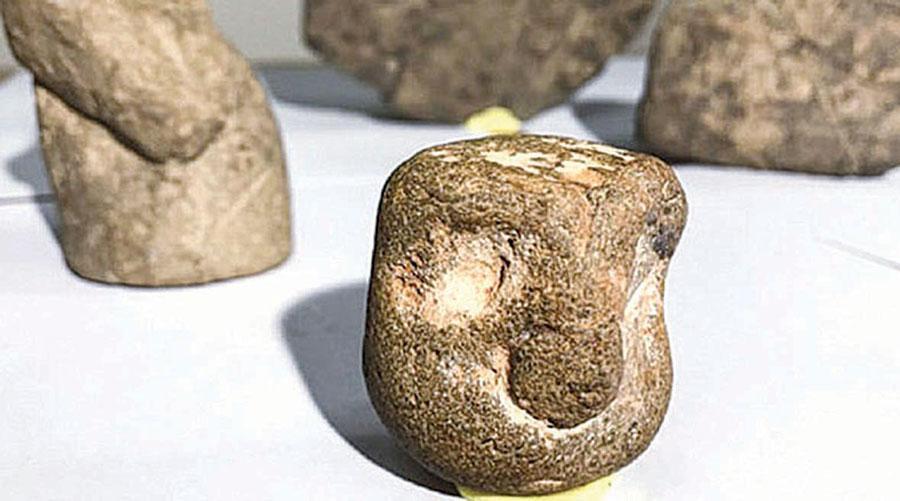Top 10 archaeological discoveries in 2018
ÖMER ERBİL

Nearly 350 archaeological excavations were carried out in 2018 in Turkey. The Culture and Tourism Ministry allocated 26 million Turkish Liras for the excavations. Nearly 50 rescue excavations are still continuing in the country.
This year’s top 10 discoveries are as follows:
Ancient port wall
Works carried out for the maintenance of the tracks of the historic Haydarpaşa Railway Station unearthed many new findings, which will shed light on Istanbul’s history.
Rescue excavations were carried out by the Istanbul Archaeology Museums for the findings, which archaeologists believe are either the ancient city walls of the Khalkedon (Kadıköy) city or the breakwater of an ancient port. The unique structure of the three-meter-wide and four-meter-deep wall corroborates to these two possibilities.
Cairn burials
Subway station excavations in Istanbul’s Beşiktaş neighborhood, carried out by the Istanbul Archaeology Museums, unveiled two figures dating back to the beginning of the Bronze Age (3,500-3,000 B.C.).
The figurines, buried in cairn-type tombs with the dead, have symbols on them but they have not been solved yet. It has been reported that similar symbols were seen in northern Balkans and in steppe cultures. As one is small and the other is big, the figurines are believed to represent a mother and a daughter.
Viking sword in the Mediterranean
A Viking sword believed to be over 1,000 years old has been unearthed during excavation works in the ancient city of Patara in the southern province of Antalya’s Kaş district.
There are two possibilities as to who the owner of the sword was. It either belonged to a soldier who had stopped by Patara during a military campaign, or belonged to a Viking who had already settled in the city.
Human-faced stone
Emre Güldoğan, an associate professor who makes surface surveys around Istanbul’s Beykoz district, discovered Paleolithic-era stones shaped in the face of a human. It has been reported that the stones were not natural but carved as a human face shape and could give important clues about the pre-historic times of Istanbul. Triangle-shaped eyes, eyebrows and a nose on the stones can be clearly seen.
Turkish traces in Anatolia
Nearly 70 rock paintings with traces of Turks in Anatolia were found in the eastern province of Kars’ Kağızman district. The rock paintings depict horses, cavalries, hunting scenes, mountain goats, reindeers and tree of life motifs.
The paintings, which are believed to date back to the Bronze Age, (3,000-1,200 B.C.), are very striking. Professor Alpaslan Ceylan, who carries out the studies, said, “The year 1071, known as the date when Turks came to Anatolia, needs to be questioned again.”
First official gazette
A 2,200-year-old and 22-lined decree was unearthed in the ancient city of Antandros during excavations headed by Professor Gürcan Polat.
The decrees, known as written steles in places like agoras in ancient cities for everyone to see and generally includes laws, are equivalent to today’s Official Gazette. The stele, dating back to the 2nd century B.C., includes a statement related to the commendation of a commander, who was sent to Antandros by Pergamum King Eumenes and his brother Attalos.
Bronze Age tombs
A research team, headed by Brenna Hassett, examined the burial types in Başur village in the eastern province of Siirt, which is a Bronze-age necropolis. A wide, coffin-like stone tomb was unearthed in this necropolis with the remains of many people buried between 3100 and 2800 B.C.
The tomb had high-status burial gifts, which were grandiose for that period. The presence of at least 11 people was determined in three tombs.
Bust of 1,700 years
A 1,700 year-old bust was unearthed in the ancient city of Soli Pompeiopolis in the southern province of Mersin’s Mezitli district. The archaeological excavations, headed by Professor Remzi Yağcı and supported by the Mersin Metropolitan Municipality, found that the bust could be the portrait of an aristocrat, administrator or commander who lived in the ancient city.
Treatment center
During excavations carried out by Professor Neşe Atik, a 2,200-year treatment center was unearthed in the northwestern province of Tekirdağ’s Karaevlialtı.
The treatment center, which belonged to the ancient city of Heraion Teichos, has many remains of medicine bottles, ovens used in medicine production, medical tools and sea snail, used as a medicine. The shells of the sea snails were also used as toothpaste, according to ancient sources.
New holy field in Troy
The head of the ancient Troy excavations, Professor Rüstem Aslan, said they unearthed findings revealing that the ancient city of Troy served as a sanctuary.
“We find those things especially in the places which were excavated in the 1930s and defined as the western sanctuary and in the field of the Temple of Athens. Further excavations will show us the existence of a sanctuary there,” Aslan said.




















